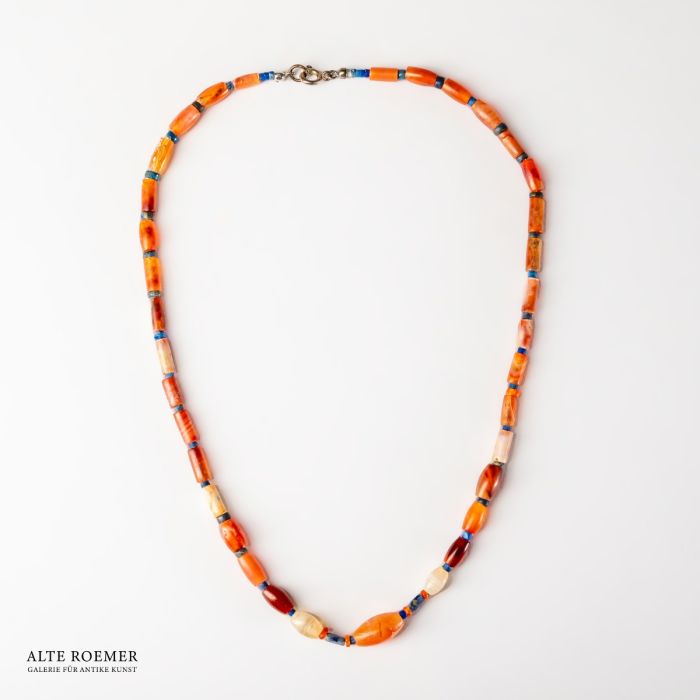Necklace of Sumerian beads
€5,500
available
Object number
AR3545-E
| Object: |
Necklace of Sumerian beads
|
| Material: |
Most of the beads are made of carnelian, some of agate, and the smaller ones of lapis lazuli.
|
| Period: |
Early Dynastic III, c. 2600 BC to 2350 BC, Time of the Ancient Sumerian Empire, Bronze Age of Mesopotamia. |
| Description: |
This beautiful necklace consists of ancient beads on a modern thread. The large beads are cylindrical, and most are made of orange-patterned carnelian, while some are made of beige-banded agate. The smaller spacer beads are made of lapis lazuli and contrast pleasantly with their rich blue. The beads are typical for the Bronze Age Near East, probably from one of the ancient Sumerian city states, although neighboring regions and eras had comparable jewellery styles. An enclosed note from the 1970s or 1980s, presumably from art dealer Anne Roselt and museum curator Dr. J. Christof Roselt, describes this even more vividly and compares the beads offered here to the beaded cloak of the Sumerian Queen Puabi, found in the royal tombs of Ur from around 2600 BC. She wore a necklace and a pectoral ornament made of very similar carnelian beads, strung in the same way with spacer beads. |
| Dimensions: |
Approximately 40cm long. The central bead is 1.5cm long.
|
| Condition: |
The ancient stone beads are intact. Minor chips may occur. Modernly strung on a white thread with silver-colored eyelets at the ends. A silver-colored clasp is included.
|
| Provenance: |
Acquired by us in 2024 from the Kaufmann family collection, Germany. Acquired by the founder of the collection, E. Kaufmann, between 1975 and 1989. It was sold by the German art dealer couple Anne and Dr. J. Christof Roselt. Dr. Roselt is better known for his tenure as director of the Bergisch Museum of Burg Castle, Germany, during which he played a pivotal role in developing and curating its cultural-historical collection. A copy of a collection note by E. Kaufmann regarding the piece is available. A note with typewritten text is enclosed, presumably by A. and C. Roselt from the 1970s or 1980s. |
| References: |
Cf. the Puabi necklace from the Royal Tombs of Ur, British Museum, museum no. 122315. Cf. Lois Sherr Dubin, The History of Beads: From 30,000 B.C. to the Present, p. 32, which additionally shows Queen Puabi's breastpiece. For a comparable piece in the art market, see Christie's New York, auction of 6 December 2000, lot 2, sold for USD 9,400, equivalent at the time to approximately EUR 10,000. |
| Authenticity: |
We unconditionally guarantee the authenticity of every artefact, all items are subject to our lifetime return policy on authenticity.
|


